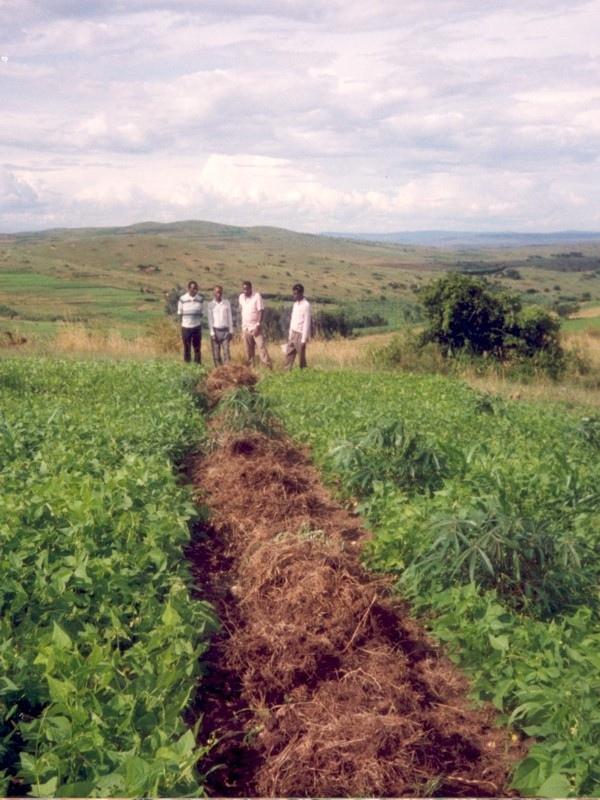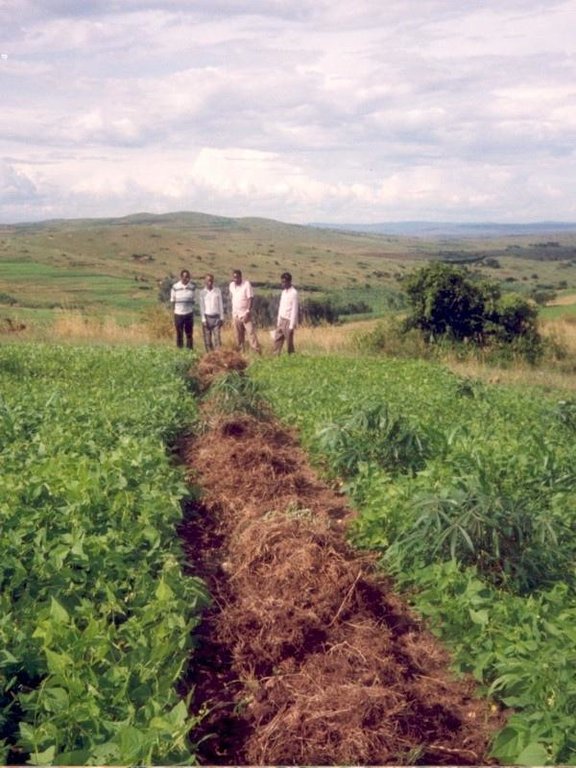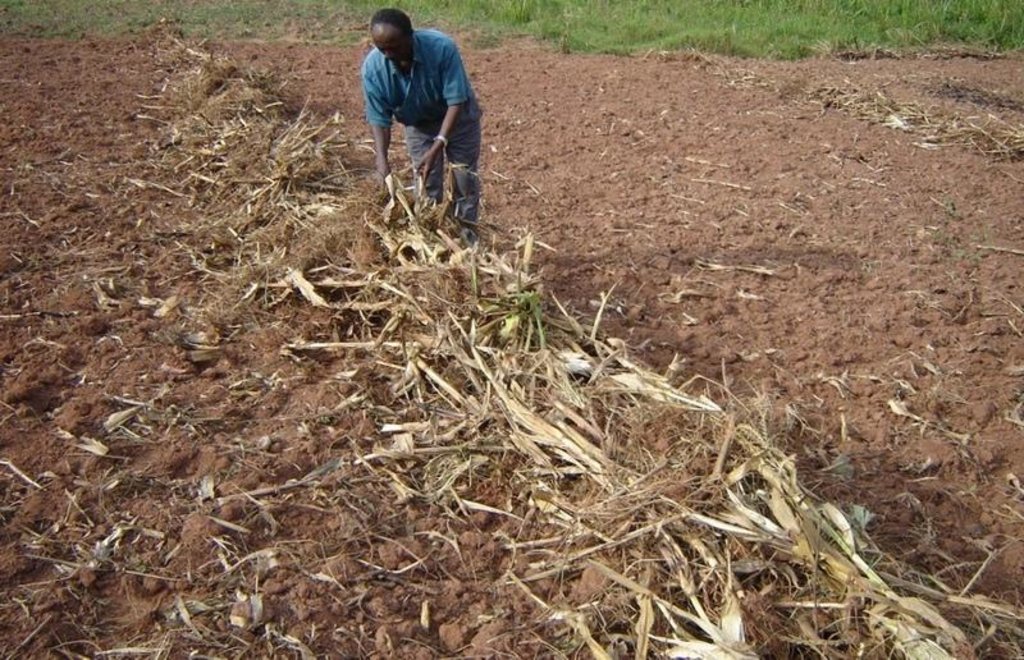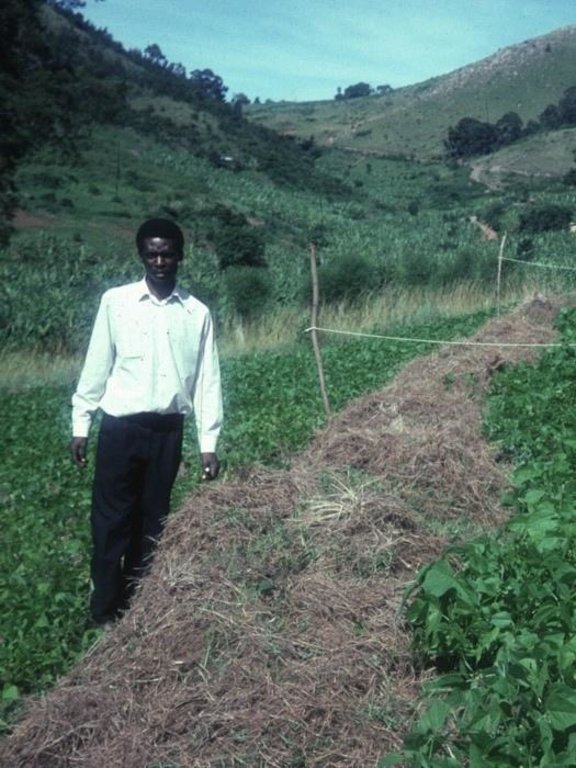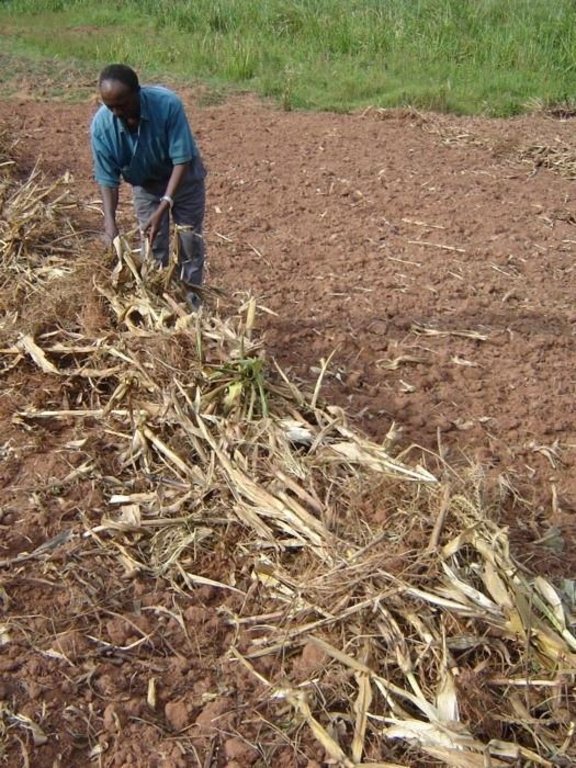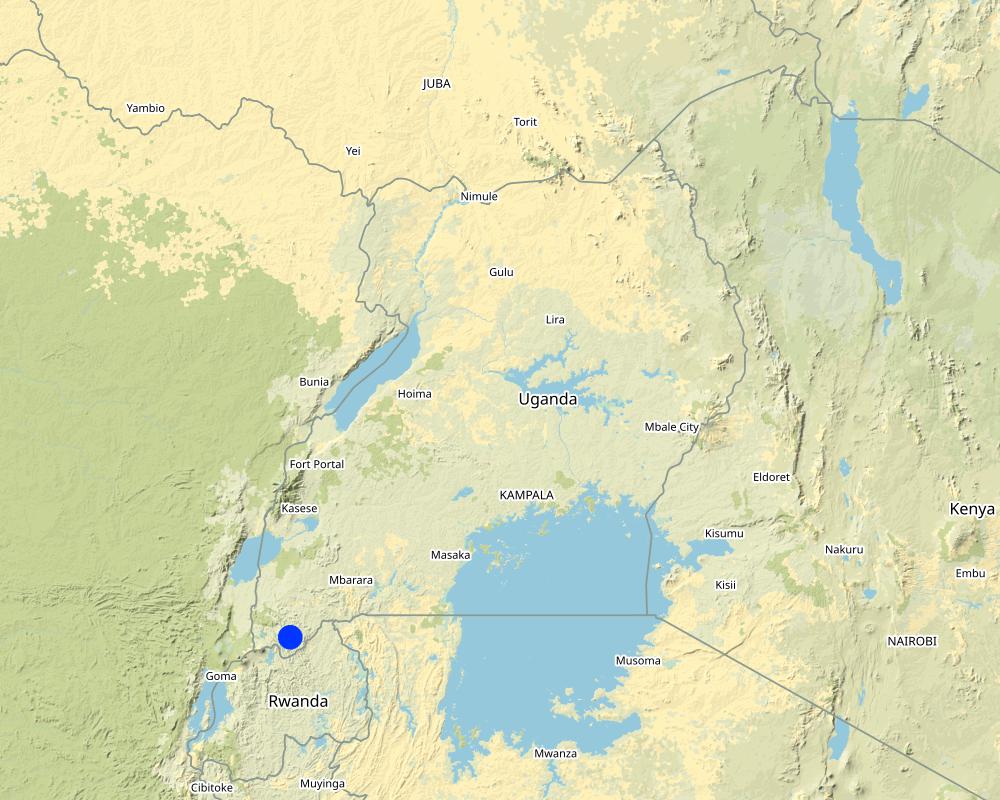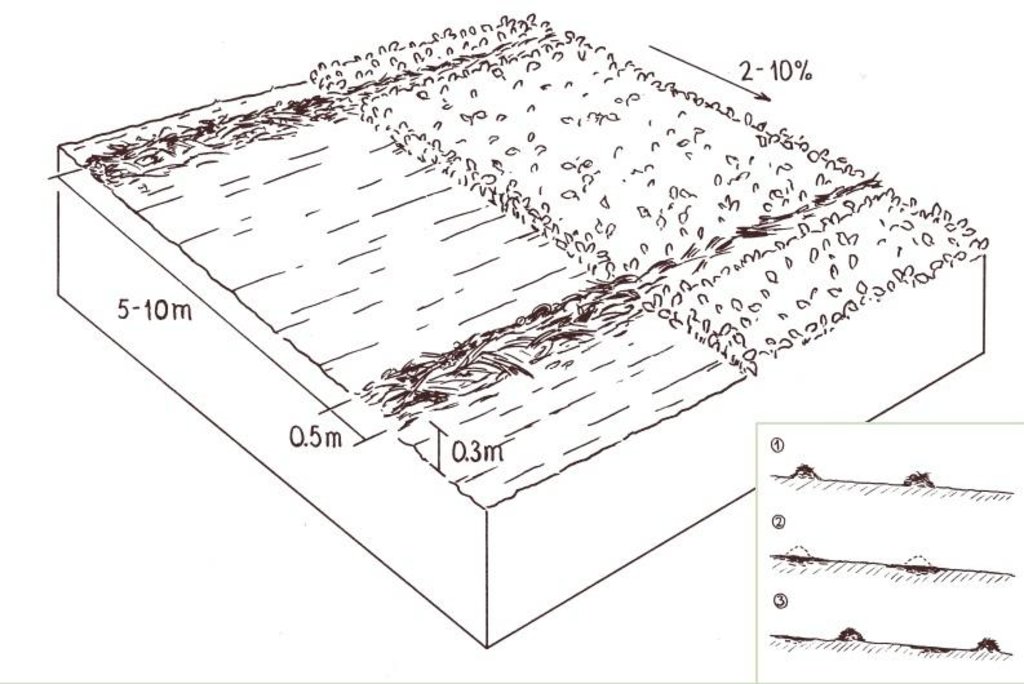Improved trash lines [Уганда]
- Создание:
- Обновить:
- Составитель: Unknown User
- Редактор: –
- Рецензенты: Alexandra Gavilano, Fabian Ottiger, Joana Eichenberger
Emikikizo (Lukiga)
technologies_990 - Уганда
Просмотреть разделы
Развернуть все Свернуть все1. Общая информация
1.2 Контактные данные специалистов и организаций, участвующих в описании и оценке Технологии
Ответственный (-ые) специалист (-ы)
Специалист по УЗП:
Miiro Henry Dan
Ministry of agriculture animal industry and fisheries - Uganda
Уганда
Название проекта, содействовавшего документированию/оценке Технологии (если применимо)
Book project: where the land is greener - Case Studies and Analysis of Soil and Water Conservation Initiatives Worldwide (where the land is greener)Название организации (-ий), содействовавших документированию/оценке Технологии (если применимо)
Ministry of Agriculture, Animal Industry, and Fisheries of Uganda (MAAIF) - Уганда1.3 Условия, регламентирующие использование данных, собранных ВОКАТ
Составитель и ответственный(-ые) специалист(-ы) согласны с условиями, регламентирующими использование собранных ВОКАТ данных:
Да
1.5 Ссылка на Анкету (ы) по Подходам УЗП (документируется с использованием ВОКАТ)
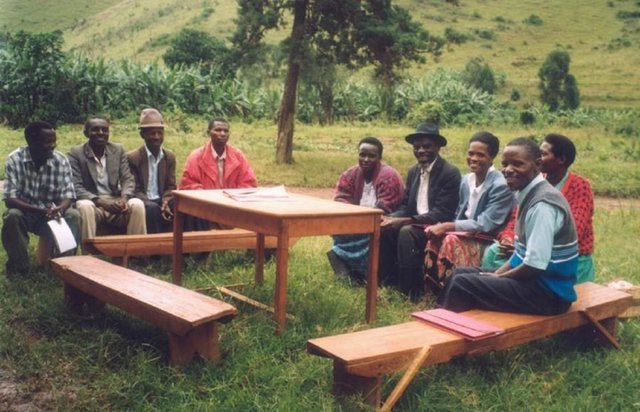
Promoting farmer innovation [Уганда]
Identification of farmer innovators in SWC and water harvesting, and using them as focal points for visits from other farmers to spread the practices and stimulate the process of innovation.
- Составитель: Kithinji Mutunga
2. Описание Технологии УЗП
2.1 Краткое описание Технологии
Определение Технологии:
Weeds and crop residues laid in bands across the slope of annual crop fields to conserve soil and water, and to incorporate organic matter into the soil after decomposition.
2.2 Подробное описание Технологии
Описание:
Trash lines of organic material across the slope constitute a traditional land husbandry practice in south-west Uganda. These traditional, ‘unimproved’, trash lines are beneficial, but even better is an improved version designed through Participatory Technology Development (PTD). Improved trash lines are smaller, closer spaced, and of longer duration than the traditional type. They are more effective in controlling runoff and maintaining soil fertility.
All trash lines (improved and traditional) are composed of cereal stover (straw) and weeds that are collected during primary cultivation (hand hoeing), and heaped in strips along the approximate contour. Creeping grasses should not be used in trash lines: they can alternatively be decomposed in bundles, and then used as mulch in nearby banana plantations. Trash lines are used in hillside fields where annual crops, including sorghum, finger millet, beans and peas, are grown. The recommended spacing between the improved trash lines is 5-10 m, depending
on the slope: the steeper the closer. The amount of material available determines the cross section of each trash line (typically ±0.5 m wide and ±0.3 m high). Improved trash lines are left in place for four seasons (there are two seasons a year in Kabale) before they are dug into the soil. Much of the material used has, by this time, decomposed or been eaten by termites. Through incorporation into the topsoil, they improve soil fertility acting effectively as ‘mobile compost strips’. New trash lines are then established between the sites of the former lines. Upkeep comprises removal of weeds that sprout within the lines - before they set seed - and the addition of more trash during each new cultivation and weeding cycle.
Improved trash lines are multipurpose in retarding dispersed runoff while, as discussed, maintaining soil fertility. They are a low-cost option for soil and water conservation. However, they need to be complemented by other measures on the steeper slopes. The climate in this part of Uganda is subhumid, with a bimodal rainfall regime, and average annual rainfall of around 800 mm. Hill tops are used for grazing, the lower slopes are cultivated with annual crops (where the trash lines are found) and the valleys are dedicated to bananas and other cash crops. Families are large: 8-10 persons, and the population density is high, at nearly 200 persons/km2.
2.3 Фотографии, иллюстрирующие Технологию
2.5 Страна/ регион/ места, где применяется Технология, информация о которых собрана в данной Анкете
Страна:
Уганда
Административная единица (Район/Область):
Kabale
Более точная привязка места:
Kabale district
Охарактеризуйте пространственное распространение Технологии :
- равномерно-однородное применение на определенной площади
Если точная область неизвестна, укажите приблизительную площадь:
- 0,1-1 км2
Пояснения:
Total area covered by the SLM Technology is 0.25 km2.
it is an indeginous technology. Widely used in various fields and at different slopes.
Map
×2.6 Сколько лет применяется данная Технология
Если год начала применения Технологии достоверно неизвестен, дайте примерную оценку:
- более 50 лет назад (традиционная)
2.7 Внедрение Технологии
Укажите, как именно Технология УЗП была внедрена:
- как часть традиционной системы землепользования (более 50 лет назад)
3. Классификация Технологии УЗП
3.1 Основные цели и задачи реализации Технологии
- повышение производства
- снижение или предотвращение деградации земель, восстановление нарушенных земель
- адаптация к изменению климата / экстремальным погодным явлениям и их последствиям
3.2 Текущий(-ие) тип(-ы) землепользования на территории, где применяется Технология

Пахотные угодья и плантации
- Однолетние культуры
- Многолетние (недревесные) культуры
- Древесные и кустарниковые культуры
Ежегодный урожай - Уточните культуры:
- зерновые культуры - просо
- зерновые культуры - сорго
- бобовые - бобы
- бобовые - зеленый горошек
Многолетние (недревесные) культуры - Уточните культуры:
- банан / подорожник / абака
- Eucalyptus
Число урожаев за год:
- 2
Поясните:
Longest growing period in days: 180 Longest growing period from month to month: Feb - Jul Second longest growing period in days: 120 Second longest growing period from month to month: Sep - Jan
Пояснения:
Major land use problems (compiler’s opinion): Continuous cultivation of annual crops on slopes prone to erosion, with little or no restitution of fertility through manures
or fertilizers.
Major land use problems (land users’ perception): continous cultivation without fallow due to small sizes of farms
3.4 Водоснабжение
Обеспеченность водой участков, где реализуется Технология :
- богарные земли
3.5 Категория УЗП, к которой относится Технология
- Улучшение почвенного/ растительного покрова
- мероприятия по влагозадержанию и снижению эрозии почв на склонах
- сбор атмосферных осадков
3.6 Мероприятия УЗП, выполняемые в рамках Технологии
3.7 Основные проблемы деградации земель, на решение которых направлена Технология

водная эрозия почв
- ВЭп: поверхностная эрозия/смыв верхних почвенных горизонтов

ухудшение химических свойств почв
- Хп: Снижение плодородия и уменьшение содержания органического вещества (вызванное не эрозией, а другими причинами)

деградация водных ресурсов
- Ва: почвенная засуха
Пояснения:
Main type of degradation addressed: Wt: loss of topsoil / surface erosion, Cn: fertility decline and reduced organic matter content
Main causes of degradation: other human induced causes (specify) (lack of communication), education, access to knowledge and support services (lack of spread of knowledge)
3.8 Предотвращение и снижение деградации земель, или восстановление нарушенных земель
Укажите цель Технологии по отношению к деградации земель :
- предотвращение деградации земель
- снижение деградации земель
Пояснения:
Main goals: mitigation / reduction of land degradation
Secondary goals: prevention of land degradation
4. Технические характеристики, мероприятия по практической реализации, вложения и стоимость
4.1 Технический рисунок, иллюстрирующий Технологию
Спецификация (пояснения к техническому рисунку):
Trash lines without crops (left)
and with crops (beans; right).
The insert shows the stages of the technology: regularly spaced trash lines are kept place for four seasons (1); then decompose over time and are incorporated into the soil (2); and finally new trash lines are placed between the previous strips (3).
Technical knowledge required for field staff / advisors: low
Technical knowledge required for land users: low
Main technical functions: control of dispersed runoff: impede / retard, increase of infiltration, increase in soil fertility
Secondary technical functions: control of dispersed runoff: retain / trap, increase in organic matter, improvement of soil structure, sediment harvesting
Agronomic measure: mulching, trash lines
Material/ species: weed residue, sorghum
Remarks: along contour
Автор:
Mats Gurtner
4.2 Общая информация по необходимым вложениям и стоимости
другая/ национальная валюта (название):
Uganda Shillings
Если это необходимо, укажите обменный курс от доллара США к местной валюте (например, 1 доллар США = 79,9 бразильского реала): 1 доллар США =:
1000,0
Укажите среднюю дневную заработную плату наемных работников:
1.00
4.4 Вложения и затраты, необходимые для начала реализации
| Опишите затраты | Единица | Количество | Затраты на единицу | Общая стоимость на единицу | % затрат, оплаченных землепользователями | |
|---|---|---|---|---|---|---|
| Оплата труда | Labour | ha | 1,0 | 25,0 | 25,0 | 100,0 |
| Оборудование | Tools | ha | 1,0 | 5,0 | 5,0 | 100,0 |
| Общая стоимость запуска Технологии | 30,0 | |||||
| Общие затраты на создание Технологии в долларах США | 0,03 | |||||
Пояснения:
Duration of establishment phase: 36 month(s)
4.5 Поддержание/ текущее обслуживание
| Деятельность | Сроки/ повторяемость проведения | |
|---|---|---|
| 1. | During land cultivation, existing (old) trash lines are dug. 2. New trash lines are then created exactly between the (cross-slope) | Dry season / each cropping season |
| 2. | The size of the trash lines depends on the amount of trash available, | Dry season |
| 3. | Weeds are added to the trash lines, and, in preparation for the second | Second season |
| 4. | Trash lines are kept free of growing weeds and built up with more | Third and fourth seasons |
| 5. | Trash lines are kept free of growing weeds and built up with moretrash. Full cycle for improved trash lines: 4 seasons (2 years) |
4.6 Стоимость поддержания/ текущего обслуживания ( в год)
Пояснения:
Machinery/ tools: hand hoe
These figures are approximate, representing a typical situation with 1,500 running metres of improved trash lines, per hectare, at a spacing of 7 m apart on a 10% slope. The 1st year (first and second seasons) involves more work than the
2nd year (third and fourth seasons): the figure given is an annual average of all work associated with trash lines. The costs of the traditional, larger and wider spaced trash lines are about 50% more than these given above - because trash has to be carried further.
4.7 Наиболее значимые факторы, влияющие на стоимость затрат
Опишите наиболее значимые факторы, влияющие на стоимость затрат:
Labour, need to collect and heap the trashlines material in lines above the slope
5. Природные и социально-экономические условия
5.1 Климат
Среднегодовое количество осадков
- < 250 мм
- 251-500 мм
- 501-750 мм
- 751-1000 мм
- 1001-1500 мм
- 1501-2000 мм
- 2001-3000 мм
- 3001-4000 мм
- > 4000 мм
Укажите среднегодовое количество осадков (если известно), мм:
800,00
Агроклиматическая зона
- Умеренно-влажная
Thermal climate class: tropics
5.2 Рельеф
Склоны (преобладающие):
- пологие (0-2%)
- покатые (3-5%)
- покато-крутые (6-10%)
- крутые (11-15%)
- очень крутые (16-30%)
- чрезвычайно крутые (31-60%)
- обрывистые (>60%)
Формы рельефа:
- плато/ равнины
- гребни хребтов/холмов
- склоны гор
- склоны холмов
- подножья
- днища долин
Зона высотной поясности:
- 0-100 м над уровнем моря
- 101-500 м н.у.м.
- 501-1000 м н.у.м.
- 1001-1500 м н.у.м.
- 1501-2000 м н.у.м.
- 2001-2500 м н.у.м.
- 2501-3000 м н.у.м.
- 3001-4000 м н.у.м.
- > 4 тыс. м н.у.м.
Комментарии и дополнительные сведения по условиям рельефа/ топографии :
Slopes on average: Also rolling and hilling (both ranked 2)
5.3 Почвы
Средняя мощность почв:
- поверхностные (0-20 см)
- неглубокие (21-50 см)
- умеренно глубокие (51-80 см)
- глубокие (81-120 см)
- очень глубокие (> 120 см)
Гранулометрический состав (верхнего горизонта):
- средние фракции (суглинистый, супесчаный)
Содержание органического вещества в верхнем горизонте:
- среднее (1-3%)
- низкое (< 1%)
Если возможно, приложите полное описание почв или укажите доступную информацию, например тип почв, рH/ кислотность почв, ёмкость катионного обмена, содержание азота, содержание солей и т.д.
Soil texture: Medium (the trash material modifies the organic matter content of the areas applied)
Soil fertility: Medium (ranked 1) and low (ranked 2)
Soil drainage/infiltration: Medium
Soil water storage capacity: Low (ranked 1) and medium (ranked 2)
5.6 Характеристика землепользователей, применяющих Технологию
Рыночная ориентация производства:
- натуральное хозяйство (самообеспечение)
- смешанный (натуральный / коммерческий)
Доходы из других источников:
- 10-50% всех доходов
Относительный уровень достатка:
- плохой
- средний
Уровень механизации:
- ручной труд
Укажите другие важные характеристики землепользователей:
1% of the land users are very rich and own 5% of the land.
5% of the land users are rich and own 10% of the land.
24% of the land users are average wealthy and own 50% of the land.
55% of the land users are poor and own 25% of the land.
Off-farm income specification: some farmers are involved in trade with nearby Rwanda and there are also a number of families who receive remittances from family members who work in Kabale or as far away as Kampala
5.7 Средняя площадь земель, используемых землепользователями с применением Технологии
- < 0,5 га
- 0,5-1 га
- 1-2 га
- 2-5 га
- 5-15 га
- 15-50 га
- 50-100 га
- 100-500 га
- 500-1000 га
- 1000-10000 га
- > 10000 га
Пояснения:
Average area of land owned or leased by land users applying the Technology: Also 1-2 ha (ranked 2) and 2-5 ha (ranked 3)
5.8 Собственность на землю, права на земле- и водопользование
Землевладелец:
- индивидуальная, не оформленная в собственность
Право землепользования:
- общинное (контролируемое)
- индивидуальное
6. Воздействия и заключительные положения
6.4 Анализ эффективности затрат
Насколько получаемый результат сопоставим с текущими расходами по поддержанию технологии (с точки зрения землепользователей)?
Эффективность затрат в краткосрочной перспективе:
позитивное
Эффективность затрат в долгосрочной перспективе:
очень позитивное
6.5 Внедрение Технологии
Пояснения:
30 land user families have adopted the Technology without any external material support
Comments on spontaneous adoption: estimates
There is a moderate trend towards spontaneous adoption of the Technology
Comments on adoption trend: the technology is indeginous. There is some evidence of growing spontaneous adoption.
6.7 Сильные стороны/ преимущества/ возможности Технологии
| Сильные стороны/ преимущества/ возможности по мнению землепользователей |
|---|
|
Improved trash lines have small but significant advantages over the traditional trash lines (which are beneficial themselves) in terms of (a) less labour (b) improved crop performance How can they be sustained / enhanced? Continue with farmer-to-farmer visits for this to be explained. |
| Сильные стороны/ преимущества/ возможности по мнению составителя или других ключевых специалистов |
|---|
|
The technology is very simple and uses locally available material. It is easy to understand, being a modification of an existing tradition How can they be sustained / enhanced? Continue with farmer-to-farmer visits for first hand learning. |
|
Multiple ecological and SWC benefits: improves soil fertility, reduces erosion, increases infiltration etc How can they be sustained / enhanced? Continue to encourage adoption of (and further farmer experimentation with) the improved trash lines. |
6.8 Слабые стороны/ недостатки/ риски Технологии и пути их преодоления
| Слабые стороны/ недостатки/ риски по мнению землепользователей | Возможные пути их преодоления/снижения? |
|---|---|
| Source of weeds | Pull out weeds before they set seed and don’t use stoloniferous or rhizome-forming (creeping) grasses in trash lines (see picture). |
| trash line harbours pest and diseases | use entirely dry grass or material |
| Слабые стороны/ недостатки/ риски по мнению составителя или ответственных специалистов | Возможные пути их преодоления/снижения? |
|---|---|
| Where land is limiting, agricultural land which would be used, is lost | uses it as a crop rotation basis |
| The trash lines are not enough on their own to control erosion on the steeper slopes | Introduce/promote supplementary structural remedies such as earth bunds. |
| Competition for crop residues which have an alternative use as livestock fodder and, especially, mulch in banana plantations | Grow hedgerows of shrubs/grasses to increase availability of material for fodder, trash lines and mulching. |
7. Справочные материалы и ссылки
7.1 Методы сбора/ источники информации
7.2 Ссылки на опубликованные материалы
Название, автор, год публикации, ISBN:
Briggs SR et al. Livelihoods in Kamwezi, Kabale District, Uganda.. 1998.
Где опубликовано? Стоимость?
Silsoe Research Institute, UK
Название, автор, год публикации, ISBN:
Mutunga K and Critchley W. Farmer’s initiatives in land husbandry Technical Report No 27. 2001.
Где опубликовано? Стоимость?
Regional Land Management Unit, Nairobi, Kenya
Название, автор, год публикации, ISBN:
Critchley W and Mutunga K .Local innovation in a global context: documenting farmer initiatives in land husbandry through WOCAT Land Degradation and Development (14) pp 143–162. 2003.
Ссылки и модули
Развернуть все Свернуть всеСсылки

Promoting farmer innovation [Уганда]
Identification of farmer innovators in SWC and water harvesting, and using them as focal points for visits from other farmers to spread the practices and stimulate the process of innovation.
- Составитель: Kithinji Mutunga
Модули
Нет модулей


